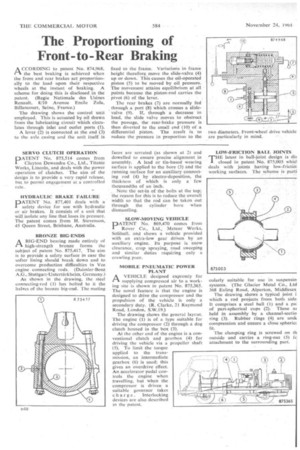The Proportioning of Front-to-Rear Braking
Page 74

If you've noticed an error in this article please click here to report it so we can fix it.
CCORDING to patent No. 874,968, L-1 the best braking is achieved When the front and rear brakes act proportionally to the load upon their respective wheels at the instant of braking. A scheme for doing this is disclosed, in the patent. (Regie Nationale des Usines Renault. 8/10 Avenue Emile Zola, Billancourt, Seine, France.)
The drawing shows the control unit employed. This is actuated by oil drawn from the lubricating circuit which circulates through inlet and outlet ports (1).
A lever (2) is connected at the end (3) to the axle casing and the unit itself is fixed to the frame. Variations in frame height therefore move the slide-valve (4) up or down. This causes the oil-operated piston (5) to be moved by oil pressure. The movement attains equilibrium at all points because the piston-rod carries the pivot (6) of the lever.
The rear brakes (7) are normally fed through a port (8) which crosses a slidevalve (9). If, through a decrease• in load, the slide valve moves to obstruct the passage, the rear-brake pressure is then diverted to the small end (10) of a differential piston. The result is to reduce the pressure in proportion to the two diameters. Front-wheel drive vehicle are particularly in mind.




















































































































